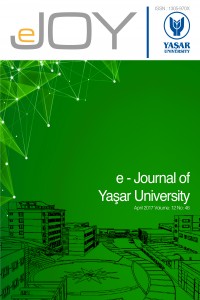The Impact of Real Effective Exchange Rate Volatility on the Trade between the U.S. and Turkey: An ARDL Approach
Öz
This paper analyses the relationship between the trade volume and the volatility of the real effective exchange rate for the case of the U.S. and Turkey. The exchange rate volatility is modeled as a GARCH(1,1) process. We employ the popular ARDL bounds testing approach to investigate the existence of a long-run relationship. Unlike most other studies, this paper uses disaggregated monthly data from ten major industries, to make the identification of industry specific effects possible. We find that in 18 out of 20 cases, the volatility of the real effective exchange rate is an insignificant regressor in the long run. Exports from Turkey to the U.S. mostly depend on the real effective exchange rate, imports to Turkey from the U.S., on the other hand, depend mostly on the Turkish industrial production index. The results of the bounds test confirm the ambiguity of the findings of previous studies.
Kaynakça
- Altintaş, Halil, Rahmi Cetin, and Bülent Öz. 2011. "The Impact of Exchange Rate Volatility on Turkish Exports: 1993-2009." South East European Journal of Economics and Business 6 (2):71-81.
- Bahmani-Oskooee, Mohsen, and Scott W Hegerty. 2007. "Exchange rate volatility and trade flows: a review article." Journal of Economic Studies 34 (3):211-255.
- Bahmani‐Oskooee, Mohsen, and ABM Nasir. 2004. "ARDL approach to test the productivity bias hypothesis." Review of Development Economics 8 (3):483-488.
- Baron, David P. 1976. "Fluctuating exchange rates and the pricing of exports." Economic Inquiry 14 (3):425-438.
- Bollerslev, Tim. 1986. "Generalized autoregressive conditional heteroskedasticity." Journal of econometrics 31 (3):307-327.
- Côté, Agathe. 1994. "Exchange rate volatility and trade." Bank of Canada Work. Pap:94-5.
- De Vita, Glauco, and Andrew Abbott. 2004. "Real exchange rate volatility and US exports: an ARDL bounds testing approach." Economic Issues 9 (1):69-78.
- Degrauwe, P. 1988. "Exchange-Rate Variability and the Slowdown in Growth of International-Trade." International Monetary Fund Staff Papers 35 (1):63-84.
- Dickey, David A, and Wayne A Fuller. 1979. "Distribution of the estimators for autoregressive time series with a unit root." Journal of the American statistical association 74 (366a):427-431.
- Engle, Robert F, and Clive WJ Granger. 1987. "Co-integration and error correction: representation, estimation, and testing." Econometrica: journal of the Econometric Society:251-276.
- Ethier, Wilfred. 1973. "International trade and the forward exchange market." The American Economic Review 63 (3):494-503.
- Franke, G. 1991. "Exchange-Rate Volatility and International Trading Strategy." Journal of International Money and Finance 10 (2):292-307.
- Hooper, Peter, and Steven W Kohlhagen. 1978. "The effect of exchange rate uncertainty on the prices and volume of international trade." Journal of International Economics 8 (4):483-511.
- Johansen, Soren. 1995. "Likelihood-based inference in cointegrated vector autoregressive models." OUP Catalogue.
- Kasman, Adnan, and Saadet Kasman. 2005. "Exchange rate uncertainty in Turkey and its impact on export volume." METU Studies in Development 32 (1):41.
- McKenzie, Michael D, and Robert D Brooks. 1997. "The impact of exchange rate volatility on German-US trade flows." Journal of International Financial Markets, Institutions and Money 7 (1):73-87.
- Ozturk, Ilhan. 2006. "Exchange rate volatility and trade: a literature survey." International Journal of Applied Econometrics and Quantitative Studies 3 (1).
- Pesaran, M Hashem, Yongcheol Shin, and Richard J Smith. 2001. "Bounds testing approaches to the analysis of level relationships." Journal of applied econometrics 16 (3):289-326.
- Schwarz, Gideon. 1978. "Estimating the dimension of a model." The annals of statistics 6 (2):461-464.
- Seabra, Fernando. 1995. "Short-run exchange rate uncertainty in Latin America." Applied economics 27 (5):441-450.
- Sercu, P., and C. Vanhulle. 1992. "Exchange-Rate Volatility, International-Trade, and the Value of Exporting Firms." Journal of Banking & Finance 16 (1):155-182.
- Sukar, Abdul-Hamid, and Seid Hassan. 2001. "US exports and time-varying volatility of real exchange rate." Global Finance Journal 12 (1):109-119.
- Vergil, Hasan. 2002. "Exchange rate volatility in Turkey and its effect on trade flows." Journal of Economic and Social Research 4 (1):83-99.
- Viaene, J. M., and C. G. Devries. 1992. "International-Trade and Exchange-Rate Volatility." European Economic Review 36 (6):1311-1321.
Ayrıntılar
| Bölüm | Makaleler |
|---|---|
| Yazarlar | |
| Yayımlanma Tarihi | 25 Nisan 2017 |
| Yayımlandığı Sayı | Yıl 2017 Cilt: 12 Sayı: 46 |


